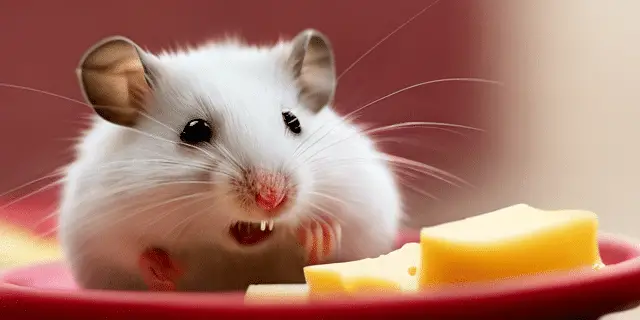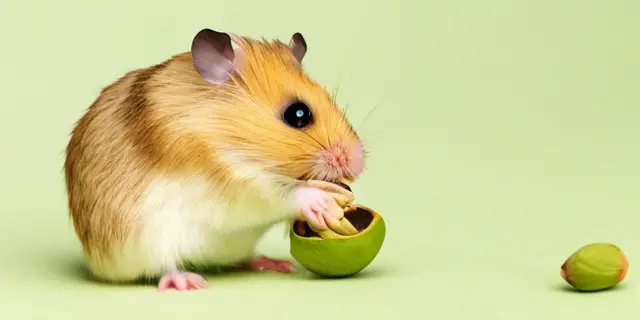Introduction
Hamsters are adorable and popular small pets known for their cute appearances, playful personalities, and relatively low maintenance requirements. As a responsible pet owner, it’s essential to understand the dietary needs and preferences of your hamster to ensure their optimal health and well-being. One common question that arises among hamster owners is whether hamsters can eat cheese. In this comprehensive article, we will explore the dietary habits of hamsters, examine the nutritional value and potential risks of feeding cheese to hamsters, and provide guidance on creating a balanced and species-appropriate diet for these beloved pets.
Understanding the Dietary Needs of Hamsters
Before delving into the question of whether hamsters eat cheese, let’s first understand the natural dietary habits and nutritional requirements of these small rodents.
Natural Diet in the Wild
In their natural habitat, hamsters are omnivores, meaning they consume both plant and animal matter. Wild hamsters primarily feed on a variety of seeds, grains, fruits, vegetables, and insects. Their diet is adapted to their native environment and provides them with the necessary nutrients for survival and reproduction.
Nutritional Requirements of Pet Hamsters
When kept as pets, hamsters have specific nutritional needs that must be met to ensure their health and longevity. A balanced hamster diet should consist of:
- High-quality hamster pellets: Commercial hamster pellets are formulated to provide a balanced mix of protein, carbohydrates, fats, vitamins, and minerals. Look for pellets that are specifically designed for hamsters and avoid those with artificial colors, flavors, or preservatives.
- Fresh fruits and vegetables: Hamsters benefit from a variety of fresh produce to supplement their diet. Some suitable options include leafy greens, carrots, cucumbers, apples, and berries. Introduce new foods gradually and in small quantities to avoid digestive upset.
- Protein sources: Hamsters require a moderate amount of protein in their diet. In addition to the protein provided by hamster pellets, you can offer small amounts of cooked egg, mealworms, or crickets as occasional treats.
- Limited treats: Treats should be given sparingly and should not exceed 10% of a hamster’s daily food intake. Stick to hamster-safe options such as unsalted sunflower seeds, pumpkin seeds, or small pieces of unsweetened whole-grain bread.
It’s crucial to provide fresh, clean water at all times and to avoid overfeeding, as obesity can lead to health problems in hamsters.
Can Hamsters Eat Cheese?
Now, let’s address the central question: Can hamsters eat cheese? While cheese is a popular food item among humans, it’s important to consider its suitability for hamsters.
Nutritional Value of Cheese
Cheese is a dairy product that is high in protein, calcium, and fat. The nutritional composition of cheese varies depending on the type and processing method. Some common types of cheese and their nutritional values per 100 grams are:
| Cheese Type | Calories | Protein (g) | Fat (g) | Carbohydrates (g) | Calcium (mg) |
|---|---|---|---|---|---|
| Cheddar | 403 | 24.9 | 33.1 | 1.3 | 721 |
| Mozzarella | 300 | 22.2 | 22.4 | 2.2 | 505 |
| Swiss | 393 | 26.6 | 31.2 | 1.4 | 791 |
| Parmesan | 431 | 38.5 | 29.2 | 3.9 | 1184 |
While cheese is a concentrated source of protein and calcium, it is also high in fat and calories, which can be problematic for hamsters.
Potential Risks of Feeding Cheese to Hamsters
Although cheese is not toxic to hamsters, there are several reasons why it should be avoided or given only in minimal amounts:
- High fat content: The high fat content in cheese can lead to obesity and related health issues in hamsters, such as diabetes, heart disease, and liver problems. Hamsters have a small body size and a slower metabolism compared to larger animals, making them more susceptible to weight gain.
- Lactose intolerance: Like many mammals, hamsters can be lactose intolerant. Lactose is a sugar found in milk and dairy products, including cheese. Feeding cheese to a lactose-intolerant hamster can cause digestive issues such as diarrhea, bloating, and abdominal pain.
- Digestive upset: The rich and complex nature of cheese can be difficult for a hamster’s digestive system to process. Introducing cheese suddenly or in large amounts can lead to gastrointestinal distress, such as vomiting or diarrhea.
- Nutritional imbalance: Overfeeding cheese to hamsters can disrupt the balance of their diet and lead to nutritional deficiencies. Cheese should not replace the essential components of a hamster’s diet, such as hamster pellets, fresh fruits, and vegetables.
- Dental issues: Hard cheeses, such as Parmesan or aged cheddar, can be difficult for hamsters to chew and may cause dental problems or choking hazards.
Safer Alternatives to Cheese
If you want to offer your hamster a treat that mimics the taste or texture of cheese, there are safer alternatives available:
- Hamster-safe commercial treats: Look for hamster treats that are specifically formulated to mimic the flavor of cheese. These treats are usually made with hamster-safe ingredients and are portion-controlled to prevent overfeeding.
- Vegetables with a cheese-like flavor: Some vegetables, such as cauliflower or nutritional yeast, have a mild cheese-like flavor and can be offered to hamsters in small amounts. However, introduce new foods gradually and monitor your hamster’s response.
- Protein-rich treats: Instead of cheese, offer your hamster protein-rich treats such as cooked egg, mealworms, or crickets. These treats provide a balanced source of protein without the high fat content and lactose found in cheese.
Remember, treats should be given in moderation and should not exceed 10% of a hamster’s daily food intake.
Creating a Balanced Diet for Hamsters
To ensure your hamster receives a balanced and nutritionally complete diet, follow these guidelines:
- Choose a high-quality hamster pellet: Provide a commercially formulated hamster pellet that meets your hamster’s nutritional needs. Look for pellets that are specifically designed for hamsters and contain a balanced mix of protein, carbohydrates, fats, vitamins, and minerals.
- Offer fresh fruits and vegetables: Supplement your hamster’s diet with a variety of fresh fruits and vegetables. Some suitable options include leafy greens, carrots, cucumbers, apples, and berries. Introduce new foods gradually and in small quantities to avoid digestive upset.
- Provide protein sources: Ensure your hamster receives adequate protein by offering small amounts of cooked egg, mealworms, or crickets as occasional treats. These protein sources should be given in moderation and should not replace the primary diet of hamster pellets.
- Limit treats: Treats, including cheese, should be given sparingly and should not exceed 10% of a hamster’s daily food intake. Stick to hamster-safe options such as unsalted sunflower seeds, pumpkin seeds, or small pieces of unsweetened whole-grain bread.
- Ensure fresh water access: Provide your hamster with fresh, clean water at all times. Water should be changed daily and the water bottle or bowl should be cleaned regularly to prevent bacterial growth.
- Monitor portion sizes: Avoid overfeeding your hamster by providing appropriate portion sizes based on their age, size, and activity level. A general guideline is to offer 1-2 tablespoons of hamster pellets per day, along with small amounts of fresh fruits, vegetables, and occasional treats.
- Regularly clean and maintain the habitat: Keep your hamster’s living environment clean and hygienic by regularly cleaning the cage, bedding, and food and water containers. A clean habitat promotes good health and prevents the spread of diseases.
By following these guidelines and providing a balanced diet, you can help ensure your hamster receives the necessary nutrients for optimal health and well-being.
Conclusion
In conclusion, while hamsters are omnivores and require a varied diet, cheese is not a recommended food item for these small pets. The high fat content, lactose, and complex nature of cheese can lead to obesity, digestive issues, and nutritional imbalances in hamsters. As a responsible pet owner, it’s crucial to prioritize your hamster’s health and provide them with a balanced





